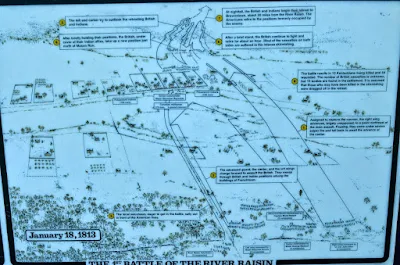This is the second of the two battles. Fir the furst please read theborevious post.
The American army camped in and around Frenchtown awake to find the woods filled with Canadian Militia and Native Americans. In addition British regular infantry and artillery are spotted. all are within musket range.
The American commander assembled his men. The Kentucky militia fell in at the works around the town. The Regulars, caught out in the open started the game in shaken status. The rifles spread out to maintain contact between the regulars and militia.
In the woods the British commander has his artillery and the 41st Regiment in the center facing the town. He plans to use his artillery to batter the militia while the regulars are held back for the final blow. On either flank a militia regiment and a war band of Natives prepared to out flank the American works and surround the enemy.
The British artillery started the game by firing on one if the militia regiments to its front. In either flank the Canadian militia and natives raced to outflank the American works. The US regular Regiment rallied off its shaken status in time to receive fire from its front and flank. But a deadly volley cut down some if the over enthusiastic warriors to their front. While the Americans passed their morale checks, counting heads they wondered how long this could last.
Keeping the Americans pinned down to their front, the Canadian infantry and Native Warriors continued to encircle the town while the artillery and muskets continued to inflict casualties. The US regulars managed to fight their way back to the town. But within their ranks many wondered how safe was that.
It was at this point that the most dramatic incident in the game occurred. As the Native Warriors moved into the town Magua saw his old enemy Colonel John Carroll of the Kentucky militia. Having vowed to kill his enemy Magua took aim at Carroll and shot him in the back. * The Militia to his right and left never noticed as they were too busy with enemies to all sides now.
At this point everything that could go wrong did go wrong. Both militia regiments failed their morale checks and routed. But they were now surrounded and no place to go. The rifles saw the British 41st regiment advancing with lowered bayonets coming towards them. And the US regulars were busy fighting enemies to their front and both sides. There was little to do but throw down their arms and surrender and hope the British could keep the Native Warriors from killing them all.
Conclusion: another quick and fast game. Just as one sided as the previous battle. But fun nevertheless. Also, how often do you get to fight two different battles with the same terrain? I think if I do this again I would give the Americans another militia regiment to give them more of a chance. Having the British/Canadian forces set up and start the game in musket range is very deadly, but also historically accurate. A little tinkering might make this a more evenly matched encounter. I enjoyed the research and learning mire about these battles. Which is after all one reason were enjoy this hobby of ours.
* in the rules I used a single figure needed to roll a 2 or less on a 10 sided dice to score a hit. Magua rolled a 1. It was very amusing as the real John Carroll is a friend on the Fife and Drum miniature forum who is always getting shot in the back in his French and Indian War or western gun fight games. I could not believe that this happened in my game. Sorry John!








































